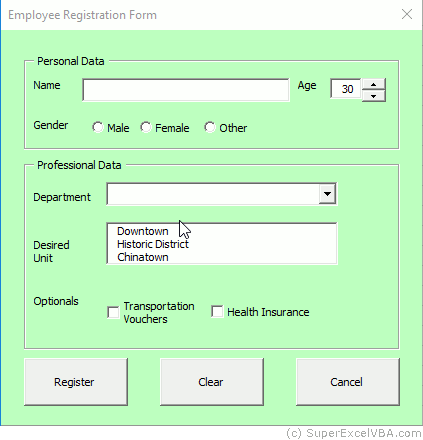Once the UserForm layout has been completed, you must configure its settings so that the options that the user has in each control have functionality. To do this, we will use the events of the UserForm.
In this way we can:
 or the list boxes
or the list boxes  , empty the text boxes
, empty the text boxes  , uncheck the option buttons
, uncheck the option buttons  , etc).
, etc).To customize the various controls (E.g. combo boxes) from the beginning of using UserForm we will use the Initialize event. This event executes the Sub code every time the UserForm is loaded into Excel memory (for example when it enters the view with  or ).
or ).
To create a startup event:

If there is no Sub in the Code Window, manually add the event described in the code below:
Private Sub UserForm_Initialize() End Sub
The VBA may have created the event Private SubUserForm_Click() automatically, delete it if you want (in this case we are setting Initialize and not Click).
By default the Subs created automatically through the VBE menus are Private. Change to Public Sub if you want to access them not only by UserForm.
Make sure that the name of the controls used in the Initialize event are the same as those created for the UserForm layout. If so, we can add the following code (to add functionality to the previous example of Userform Layout):
Private Sub UserForm_Initialize()
'Clears the text box
TextBox1.Value = ""
'Fills in the initial age
TextBox2.Value = 30
'Sets the initial age
SpinButton1.Value = 30
'Clears the option buttons
OptionButton1.Value = False
OptionButton2.Value = False
OptionButton3.Value = False
'Clears the combo box
ComboBox1.Clear
'Fills in the combo box
With ComboBox1
.AddItem "Purchasing Department"
.AddItem "Finance Department"
.AddItem "Legal Department"
.AddItem "Planning Department"
.AddItem "Human Resources Department"
.AddItem "IT Department"
.AddItem "Sales Department"
.Style = 2 'Prevents the user from entering an input that is not on the list
End With
'Clears the list box
ListBox1.Clear
'Populate the list box
With ListBox1
.AddItem "Downtown"
.AddItem "Historic District"
.AddItem "Chinatown"
End With
'Clears the check boxes
CheckBox1.Value = False
CheckBox2.Value = False
End Sub
To display the UserForm you need to run a macro like the following:
Sub ShowForm()
UserForm1.Show
End Sub
This macro, inserted in a
, can be assigned to a button in a worksheet, or run in response to a user triggered event.
Note that after setting the Initialize event, if the UserForm is called (Show) the button options will already be available:

Although the initial control options have been configured, still more settings are required to the operation of all functionalities of the form (E.g.: command buttons, spin buttons, etc.).
When executing the Show command and displaying the UserForm, the worksheet is usually locked for editing, however we can change it with parameterization.
Sub ShowForm()
UserForm1.Show 0 'vbModeless
End Sub | Configuration | Value | Description |
|---|---|---|
| vbModal | 1 | UserForm is a modal window. Default option. |
| vbModeless | 0 | UserForm is not a modal window |
SuperExcelVBA.com is learning website. Examples might be simplified to improve reading and basic understanding. Tutorials, references, and examples are constantly reviewed to avoid errors, but we cannot warrant full correctness of all content. All Rights Reserved.
Excel ® is a registered trademark of the Microsoft Corporation.
© 2025 SuperExcelVBA | ABOUT